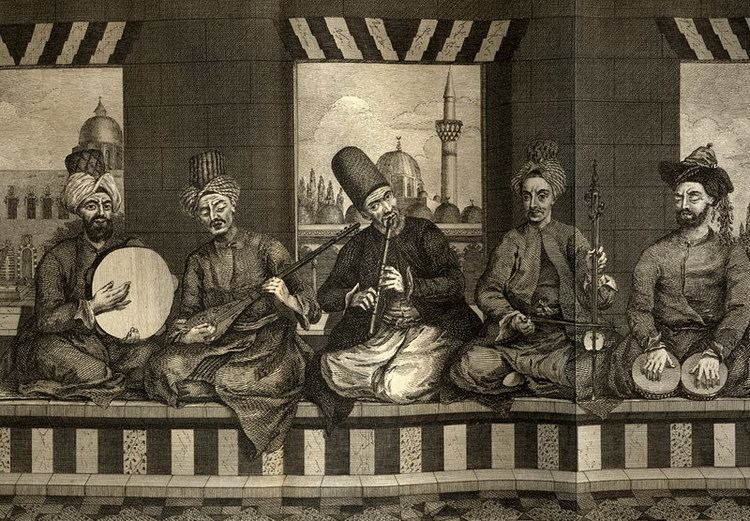 | ||
Ethnic music Armenian
Azeri
Bosnian
Greek
Jewish
Kurdish Turkish marches Tenth year March
Ottoman marches Music awards Turkey Music Awards
Mü-Yap
Golden Microphone
Golden Butterfly Awards Music charts Kral Top 20
Turkey Top 20
Billboard charts Music festivals International Music Festival
International Jazz Festival
Izmir European Jazz Festival
Aspendos festival Music media Kral
Musiki Mecmuası
NR 1
Dream
Powertürk | ||
Classical Turkish music (Turkish: Türk sanat müziği, "Turkish art music"; or Klasik Türk müziği, "Classical Turkish music"), sometimes known as Ottoman classical music, developed in Istanbul and other major Ottoman cities and towns through the palaces and Sufi lodges of the Ottoman Empire. Above all a vocal music, Ottoman music traditionally accompanies a solo singer with a small instrumental ensemble. In recent times, instruments might include tambur (lute), ney (flute), kemençe (fiddle), keman (Western violin), kanun (zither), or other instruments. Sometimes described as monophonic music, the variety of ornamentation and variation in the ensemble requires the more accurate term heterophonic.
Contents
Overview
Ottoman music has a large and varied system of modes or scales known as makams, and other rules of composition. There are more than 600 makams that have been used so far. Out of these, at least 119 makams are formally defined, but today only around 20 makams are widely used. In the Sufi teaching, each makam represents and conveys a particular psychological and spiritual state. Sometimes, in certain makams, Ottomans would use different instrumental and vocal musical pieces in order to cure certain medical and psychological conditions.
A number of notation systems were used for transcribing classical music, the most dominant being the Hamparsum notation in use until the gradual introduction of western notation. Turkish classical music is taught in conservatories and social clubs, the most respected of which is Istanbul's Üsküdar Musiki Cemiyeti.
A specific sequence of classical Turkish musical forms become a fasıl, a suite an instrumental prelude (peşrev), an instrumental postlude (saz semaisi), and in between, the main section of vocal compositions which begins with and is punctuated by instrumental improvisations (taksim). A full fasıl concert would include four different instrumental forms and three vocal forms, including a light classical song, şarkı. A strictly classical fasıl remains in the same makam throughout, from the introductory taksim to the end, which is usually a dance tune or oyun havası. However shorter şarkı compositions, precursors to modern day songs, are a part of this tradition, many of them extremely old, dating back to the 14th century; many are newer, with late 19th century songwriter Haci Arif Bey being especially popular. Tanrıkorur argues that the perceived differences between the traditional music genres stemmed from the cultural clash between the East and the West that emerged during the Tanzîmat Era (1839-1908).
Musical instruments
Traditional instruments in Ottoman classical music today include tanbur long-necked plucked lute, ney end-blown flute, kemençe bowed fiddle, oud plucked short-necked unfretted lute, kanun plucked zither, violin, and in Mevlevi music, kudüm drum. Older instruments still in use include lavta.
Forms
Ottoman classical music comprises many vocal and instrumental forms, among which are the suites called fasıl. A fasıl typically includes many instrumental and/or vocal movements, including taksim, peşrev, şarkı, beste, and kar, among others.
Genres
Ottoman music has various genres including the spiritual, improvised ("gazel", "kaside", "durak", etc.) and fasil music.
Composers and Performers
Other famous proponents of this genre include Dede Efendi, Prince Cantemir, Baba Hamparsum, Kemani Tatyos Efendi, Sultan Selim III, and Sultan Suleiman the Magnificent. The most popular modern Turkish classical singer is Münir Nurettin Selçuk, who was the first to establish a lead singer position. Other performers include Bekir Sıdkı Sezgin, Alaeddin Yavaşça, Müzeyyen Senar, Emel Sayın and Zekai Tunca.
Other Composers
